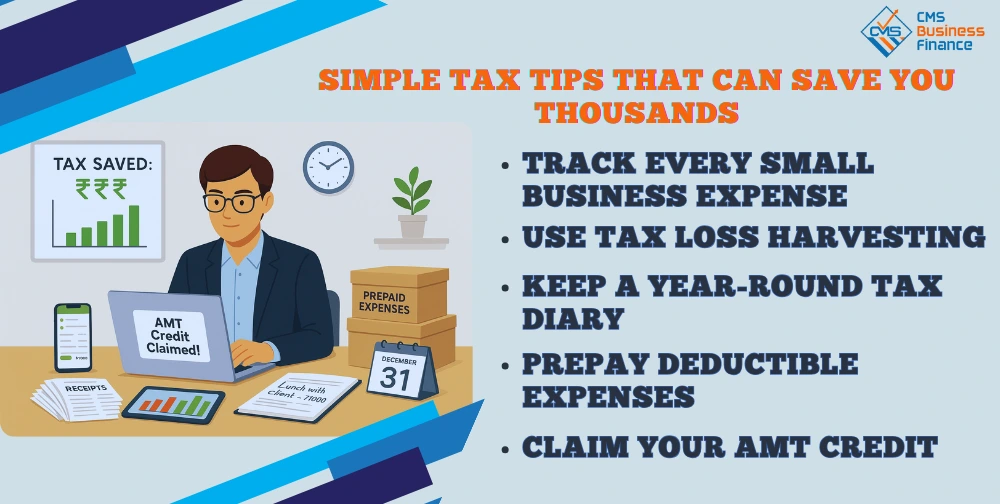- Trick #1: Track Every Small Business Expense
Most entrepreneurs are keen to record larger expenditures like rent or equipment buys, but they fail to see those small day-to-day expenses that quickly accumulate. A ₹250 parking fine here, a ₹1,000 lunch with a client there- at the end of the year, these can turn into thousands of rupees in deductions you have missed. According to the Income Tax Act, any ordinary and necessary expense incurred for carrying on business is deductible, regardless of its quantum.
The smartphone has made this simple— you can easily download an expense tracker or keep a very simple spreadsheet. You should take pictures of all the receipts and categorize them as office supplies, client meetings, or professional subscriptions. The only thing that matters is discipline; when you review your expenses often, you record most of them and minimize stress during the tax season.
And one thing! Never claim personal expenses as a business; this is the flaming red flag that invites an audit. Staying on top of your records is also critical when applying for funding through companies like CMS Business Finance, which values transparency and well-managed ideas when offering tailored financial support to small businesses.
- Trick #2: Use Tax Loss Harvesting
If you’re investing in the stock market, you know that not all investments work out. Nevertheless, you can use a strategy known as tax loss harvesting to turn even your losing investments into profitable ones. By selling underperforming assets, the gains achieved through profitable investments are offset, reducing overall tax liability.
In any fiscal year, regular income may be reduced by up to ₹2,50,000 if losses exceed gains, with any excess losses being carried forward. This tends to work exceptionally well for high earners in the higher tax brackets. The most important consideration is the “wash sale rule,” which bars buying back the same or a substantially identical asset within 30 days of selling it. To rebalance your portfolio, consider reinvesting in a similar mutual fund or ETF. Used strategically, this could net a tax savings that amounts to several lakhs without any meaningful changes in long-term investment strategy.
- Trick #3: Keep a Year-Round Tax Diary
Too many taxpayers end up losing precious deductions simply because they forget them by the time tax season rolls around. This is where a tax diary comes into play. By writing down deductible events like mileage, client meetings, and business lunches at the time they happen, you ensure that no write-off goes by without being accounted for.
The Income Tax Department values contemporaneous records, actual records kept contemporaneously have much more weight than those reconstructed months later. It is not necessary for a tax diary to be complicated. It could be as simple as taking quick notes on your phone, voice memos, or using a mileage tracker for business travel. Something as simple as “Met client at café to discuss project” could have significance if your returns are ever scrutinized. Before long, you will have an impeccable record to defend your deductions and further your savings.
- Trick #4: Prepay Deductible Expenses
One of the smarter year-end tax-reduction strategies is to accelerate the payment of certain deductible expenses. If you happen to be in a situation where you earn more this year than you expect to earn next year, you can shift the payment of costs—such as insurance premiums, office supplies, subscriptions, and professional dues—to this year to take the deduction.
This is handy for self-employed professionals or small business owners whose annual net income may vary from year to year. Prepayment, however, does not involve incurring any new, unnecessary expenditures but rather relates to the acceleration of costs that would, at some later time, have been incurred. It lowers the amount of taxable income in a high-earning year and allows one to retain more of what one has earned at a time when it is needed. Intelligent planning can further facilitate cash flow for other needs, such as expanding operations locally or considering various financial options, including a best business loan in Chennai for long-term growth.
- Trick #5: Claim Your AMT Credit
If you’ve found yourself paying some AMT, chances are that you are entitled in some way to a refund in subsequent years. Quite a few taxpayers, and even some professionals, tend to ignore keeping tabs on this valuable credit. The AMT was established to ensure that individuals with high incomes pay a minimum amount of taxes, but if your income changes in any way within, then you may be able to recoup a part of what you had paid.
To recover it, you could check on prior tax returns for AMT paid and the forms to claim it back if applicable. The rules tend to be quite tricky, so it would be an advantage to hire a tax expert to ensure you aren’t missing out on anything. A history of AMT paid in prior years may result in significant future savings. Do not let the IRS hold on to unclaimed credits when it could be turned into money for you.




